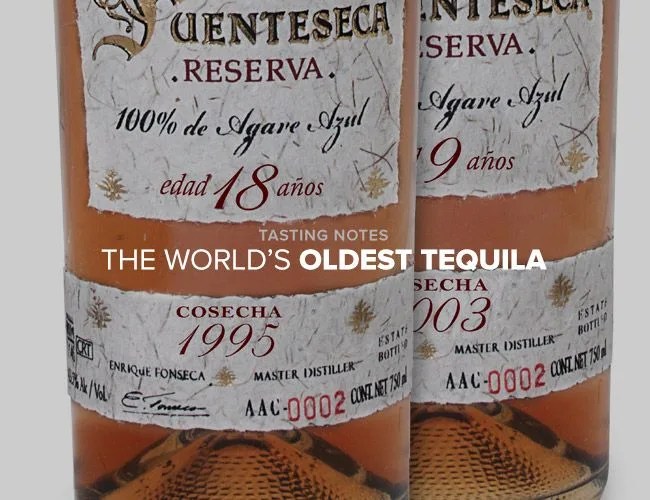In a more modest rendition of the hero’s journey, Enrique Fonseca left his home of Guadalajara, Jalisco, to study Visual Arts and English in Toronto, only to return years later to help work his father’s agave fields. After local distilleries colluded to limit the prices they paid farmers, Fonseca bought his own. A traditional tequila distillery would have only included pot stills, which typically produce a flavorful, low ABV alcohol, but Fonseca’s distillery — purchased from the ultra-large Bacardi — also came with double-column stills. After Fonseca added agave roasting ovens, fermentation tanks and a number of barrel facilities, he possessed all the tools to make a wide-variety of alcohols…or a few unique takes on a single variety. He took the second path, producing mixes of double-column and pot still tequilas that he started aging in a 24,000 barrel, football field-sized warehouse behind his home. One of them is the oldest tequila available.
TAKE OUT THE WORM: 1800 Milenio | Partida Anejo Tequila | Espolon Reposado Tequila
Years passed after the initial round of production. The tequila sat. Fonseca, who made the aged tequila simply because he loves it, refused to release it as a commercial offering. But Jacob Lustig, an American spirits importer with Haas Brothers known for working with high quality tequilas, recently convinced Fonseca to bottle and ship some of his tequila. The resulting product — Lote Fuenteseca 9, 12 and 18 Year Old — are billed as the oldest tequilas in the world.
The first tequila in the line, Lote Fuenteseca 9 year, contains 80 percent tequila distilled in copper double-column stills and 20 percent tequila distilled in alembic copper pot stills. Over fifteen days, the tequilas get mixed, and then the resulting mixture gets split again and aged in two different barrels: American white oak, previously used to age California red wine, and French oak. After nine years, the tequila is bottled at 43 percent ABV. It’s an exquisite tequila, perfect for sipping, with notes of agave and marzipan that blend with the subtle vanilla imparted by the oak.
The Lote Fuenteseca 12 Year inverts the 9 Year formula, using 20 percent tequila from copper double-column stills and 80 percent tequila from alembic copper pot stills. The resulting mixture gets blended and then split into American white oak and French oak for twelve years of aging. At 45 percent ABV, the 12 Year is the strongest of the three expressions, and perhaps the most spirited, trading the 9 year’s earthy green apple notes for spritely red apple.
Finally, there’s the world’s oldest tequila, the Lote Fuenteseca 18 year. Distilled in September 1995, it spent one year aging in oak before getting stored in a warehouse with tequilas from 17 other Fonseca production runs, all stored in 180L Canadian white oak casks previously used by Seagram’s for aging rye whiskey. After five years, the 18 spirits are blended and redistributed between Canadian white oak casks (47 percent) and 220L European oak casks previously used to age California red wine (53 percent). The casks then spend an additional 12 years in a cooler, breezier facility before the tequila gets blended and bottled at 43.5 percent ABV. It’s light and unadulterated, daunting in its complexity, as flavors like green apple, vanilla and cedar come and go almost before you can get a handle on them.
There might not be better tequila on the market. But although they’re near perfect, and incredibly old, we respect them most because they represent a labor of love, a product formed by someone with a deep respect for alcohol and tradition, someone who said, “I started this project because I wanted to make the best tequila possible, regardless of time or cost.” According to distributors, only 1,000 bottles of all three products came to the United States, with the majority of those going to high-end bars in California, Colorado and New York. Western locations are a well-kept secret, but Manhattanites should check out Bouley, Daniel and the NoMad.

